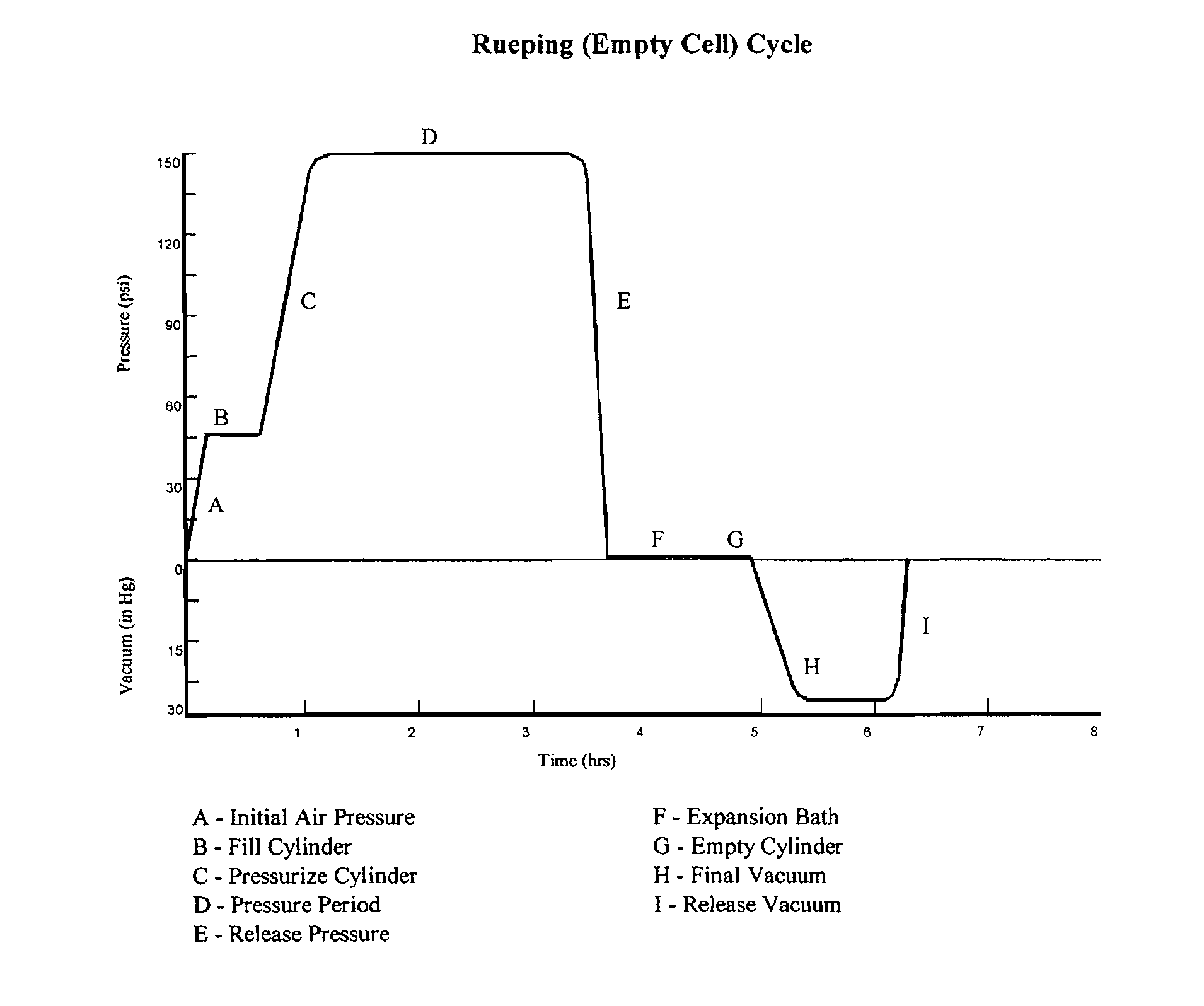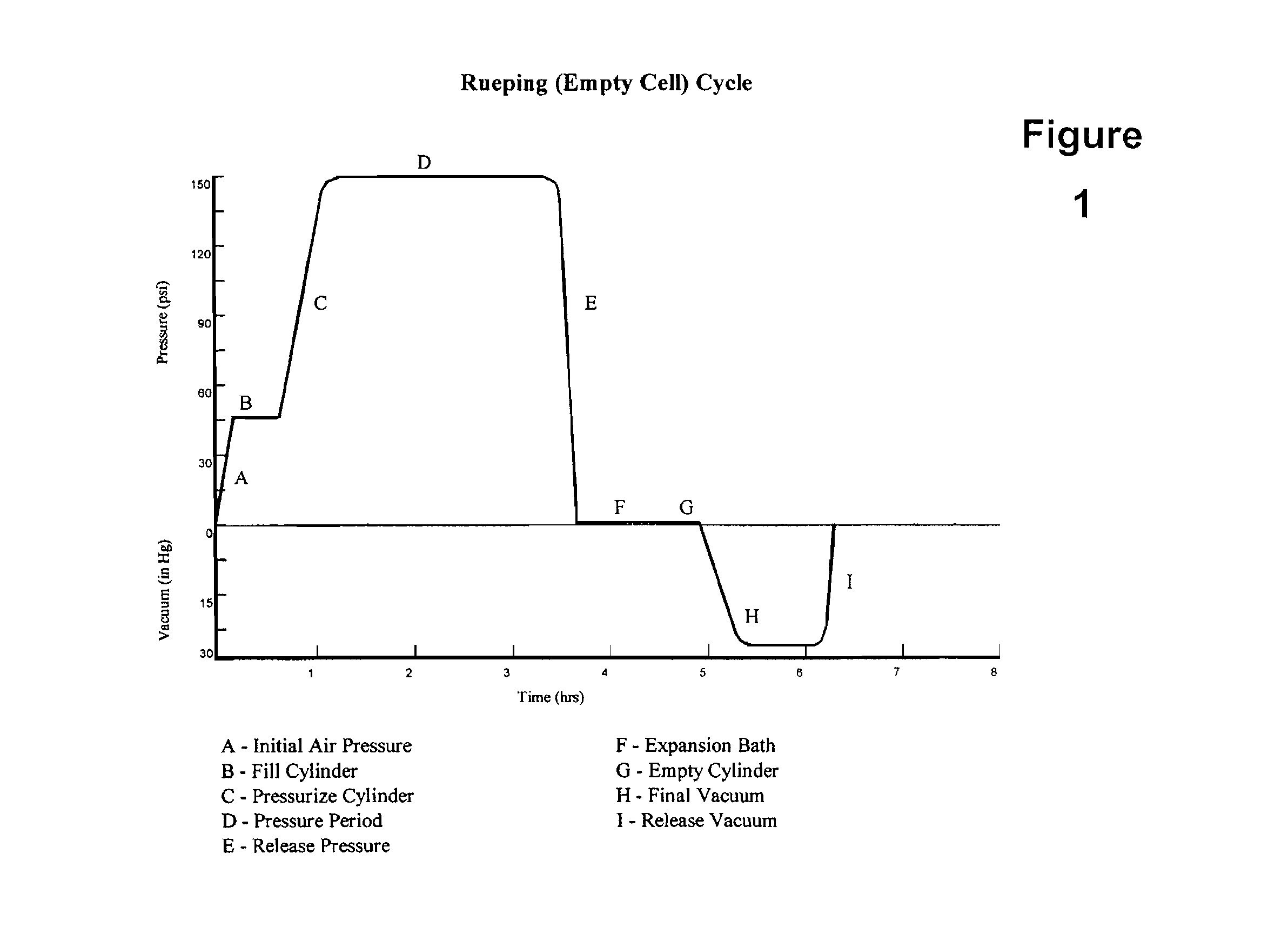Single step creosote/borate wood treatment
a single-step, wood treatment technology, applied in the direction of biocide, wood heating, manufacturing tools, etc., can solve the problems of insufficient protection against soft rot fungi, deterioration of wood products, and easy weathering, and achieve the effect of eliminating the six-week borate treatment step and high moisture conten
- Summary
- Abstract
- Description
- Claims
- Application Information
AI Technical Summary
Benefits of technology
Problems solved by technology
Method used
Image
Examples
example 1
Preparation of a Borate / Creosote Solution
[0040]All boron sources used were AWPA 2010 compatible and expressed as Boric Acid Equivalent (BAE) which is B2O3. The objective was to determine whether Tim-Bor (disodium octaborate tetrahydrate or D.O.T.) could be dissolved in creosote, or a co-solvent which could then be added to creosote.
Treatments: Monoethanolamine Borate Ester
[0041]Monoethanolamine (non-ester)
[0042]creosote
[0043]biodiesel
Control: water
Replications: Each treatment was replicated three times.
[0044]Ten grams of Tim-Bor was added to round bottomed flasks containing 100 mL of each treatment. The flasks were then attached to a rotary evaporator (Büchi R-124) for 1 hour at 60 rpm and a temperature of 80° C.
[0045]All results were qualitative in nature, did the Tim-Bor dissolve in the treatment or not? The basis of this was, if the solution was free of clumps or clouds then the Tim-Bor was considered to be dissolved. The flasks were then capped and allowed to cool for 24 hours a...
example 2
Effect of Varying Amounts and Types of Borate Preservatives Added to Creosote on Diffusion of Borate into Wood Treated with the Disclosed one Stage Process
[0047]The objective was to examine the effect of varying amounts and types of borate preservatives added to creosote on diffusion of borate into wood treated with one stage creosote / borate in a mini-pilot wood treating plant.
Treatments:
[0048]1% Tim-Bor
[0049]1% Tim-Bor / monoethanolamine borate ester
[0050]1% monoethanolamine borate ester
[0051]5% Tim-Bor
[0052]5% Tim-Bor / monoethanolamine borate ester
[0053]5% monoethanolamine borate ester
Control:
[0054]100% creosote
[0055]Twenty-eight hardwood stakes were cut measuring 2 in×2in×12in each. 2 L of each preservative treatment mixture was needed per charge in the mini-pilot wood treating plant (Canadian Erectors Manufacturing Ltd.). The wood stakes were treated using the Lowry process with a steam coil heater operating at 180° F. during the initial bath and pressure cycle. Each charge took ap...
example 3
Amount of Stabilizer Required to Prevent From Coming out of Solution
[0059]Experiment were undertaken to determine the minimum amount of stabilizer, in the form of biodiesel, that needs to be added to the highly concentrated MBE (52% boric acid) to prevent boron from coming out of solution and forming deposits.
Treatments:
[0060]50% monoethanolamine borate ester / 50% biodiesel
[0061]75% monoethanolamine borate ester / 25% biodiesel
[0062]85% monoethanolamine borate ester / 15% biodiesel
[0063]90% monoethanolamine borate ester / 10% biodiesel
Control:
[0064]100% monoethanolamine borate ester (52%)
[0065]Fifteen 3.8L metal containers were each half filled with the appropriate treatment or control. The contents were agitated by stirring and the solution was allowed to coat the sides of the cans. This was to mimic the handling of drums prior to transport and storage. The containers were then allowed to sit undisturbed for a period of one month. The container contents were checked weekly and observation...
PUM
| Property | Measurement | Unit |
|---|---|---|
| pressure | aaaaa | aaaaa |
| temperature | aaaaa | aaaaa |
| pressure | aaaaa | aaaaa |
Abstract
Description
Claims
Application Information
 Login to View More
Login to View More - Generate Ideas
- Intellectual Property
- Life Sciences
- Materials
- Tech Scout
- Unparalleled Data Quality
- Higher Quality Content
- 60% Fewer Hallucinations
Browse by: Latest US Patents, China's latest patents, Technical Efficacy Thesaurus, Application Domain, Technology Topic, Popular Technical Reports.
© 2025 PatSnap. All rights reserved.Legal|Privacy policy|Modern Slavery Act Transparency Statement|Sitemap|About US| Contact US: help@patsnap.com



